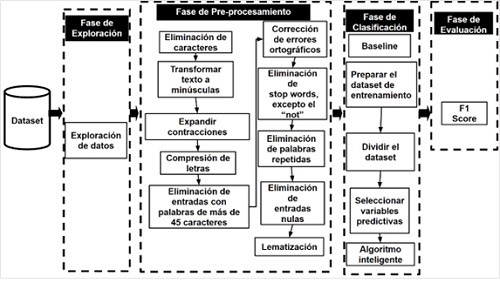Sentiment analysis in Twitter
A comparative study
DOI:
https://doi.org/10.51252/rcsi.v3i1.418Keywords:
sentiment analysis, learning, classification, twitterAbstract
Sentiment analysis helps to determine the perception of users in different aspects of daily life, such as product preferences in the market, level of user confidence in work environments, or political preferences. The idea is to predict trends or preferences based on feelings. In this article we evaluate the most common techniques used for this type of analysis, considering machine learning and deep machine learning techniques. Our main contribution is based on a proposal for a methodological strategy that covers the phases of data preprocessing, construction of predictive models and their evaluation. From the results, the best classical model was SVM, with 78% accuracy, and 79% F1 metric (F1 score). For the Deep Learning models, the classical models had the best results. The model with the best performance was the Deep Learning Long Short Term Memory (LSTM), reaching 88% accuracy and 89% F1 metric. The worst of the Deep Learning models was the CNN, with 77% accuracy as an F1 metric. Concluding that the Long Short Term Memory (LSTM) algorithm proved to be the best performance, reaching up to 89% accuracy.
References
Abirami, A. M., & Gayathri, V. (2017). A survey on sentiment analysis methods and approach. 2016 Eighth International Conference on Advanced Computing (ICoAC), 72–76. https://doi.org/10.1109/ICoAC.2017.7951748
Al-Ayyoub, M., Khamaiseh, A. A., Jararweh, Y., & Al-Kabi, M. N. (2019). A comprehensive survey of arabic sentiment analysis. Information Processing & Management, 56(2), 320–342. https://doi.org/10.1016/j.ipm.2018.07.006
Angiani, G., Ferrari, L., Fontanini, T., Fornacciari, P., Iotti, E., Magliani, F., & Manicardi, S. (2016). A comparison between preprocessing techniques for sentiment analysis in Twitter. CEUR Workshop Proceedings, 1748, 1–11. https://ceur-ws.org/Vol-1748/paper-06.pdf
Baby, C. J., Khan, F. A., & Swathi, J. N. (2017). Home automation using IoT and a chatbot using natural language processing. 2017 Innovations in Power and Advanced Computing Technologies (i-PACT), 1–6. https://doi.org/10.1109/IPACT.2017.8245185
Breck, E., & Cardie, C. (2017). Opinion Mining and Sentiment Analysis. In The Oxford Handbook of Computational Linguistics 2nd edition. Oxford University Press. https://doi.org/10.1093/oxfordhb/9780199573691.013.43
Cambria, E. (2016). Affective Computing and Sentiment Analysis. IEEE Intelligent Systems, 31(2), 102–107. https://doi.org/10.1109/MIS.2016.31
Chaturvedi, I., Cambria, E., Welsch, R. E., & Herrera, F. (2018). Distinguishing between facts and opinions for sentiment analysis: Survey and challenges. Information Fusion, 44, 65–77. https://doi.org/10.1016/j.inffus.2017.12.006
Chu, E., & Roy, D. (2017). Audio-Visual Sentiment Analysis for Learning Emotional Arcs in Movies. 2017 IEEE International Conference on Data Mining (ICDM), 829–834. https://doi.org/10.1109/ICDM.2017.100
De Albornoz, J. C., Plaza, L., Gervás, P., & Díaz, A. (2011). A Joint Model of Feature Mining and Sentiment Analysis for Product Review Rating. In Advances in Information Retrieval (pp. 55–66). https://doi.org/10.1007/978-3-642-20161-5_8
Desai, M., & Mehta, M. A. (2016). Techniques for sentiment analysis of Twitter data: A comprehensive survey. 2016 International Conference on Computing, Communication and Automation (ICCCA), 149–154. https://doi.org/10.1109/CCAA.2016.7813707
Dobbin, K. K., & Simon, R. M. (2011). Optimally splitting cases for training and testing high dimensional classifiers. BMC Medical Genomics, 4(1), 31. https://doi.org/10.1186/1755-8794-4-31
Giachanou, A., & Crestani, F. (2016). Like It or Not: A Survey of Twitter Sentiment Analysis Methods. ACM Computing Surveys, 49(2), 1–41. https://doi.org/10.1145/2938640
Go, A., Bhayani, R., & Huang, L. (2009). Twitter Sentiment Classification using Distant Supervision. Processing, 1–6. https://www-cs-faculty.stanford.edu/people/alecmgo/papers/TwitterDistantSupervision09.pdf
Grus, J. (2015). Data Sciemce from Scratch: first principles with python (1st ed.). O’Reilly Media.
Hu, M., & Liu, B. (2004). Mining and summarizing customer reviews. Proceedings of the 2004 ACM SIGKDD International Conference on Knowledge Discovery and Data Mining - KDD ’04, 168. https://doi.org/10.1145/1014052.1014073
Hussein, D. M. E.-D. M. (2018). A survey on sentiment analysis challenges. Journal of King Saud University - Engineering Sciences, 30(4), 330–338. https://doi.org/10.1016/j.jksues.2016.04.002
Jianqiang, Z., & Xiaolin, G. (2017). Comparison Research on Text Pre-processing Methods on Twitter Sentiment Analysis. IEEE Access, 5, 2870–2879. https://doi.org/10.1109/ACCESS.2017.2672677
Kao, A., & Poteet, S. R. (2007). Natural Language Processing and Text Mining (1st ed.). Springer London. https://doi.org/10.1007/978-1-84628-754-1
Kaur, H., Mangat, V., & Nidhi. (2017). A survey of sentiment analysis techniques. 2017 International Conference on I-SMAC (IoT in Social, Mobile, Analytics and Cloud) (I-SMAC), 921–925. https://doi.org/10.1109/I-SMAC.2017.8058315
Kharde, V. A., & Sonawane, S. S. (2016). Sentiment Analysis of Twitter Data: A Survey of Techniques. International Journal of Computer Applications, 139(11), 5–15. https://doi.org/10.5120/ijca2016908625
Li, W., Shao, W., Ji, S., & Cambria, E. (2022). BiERU: Bidirectional emotional recurrent unit for conversational sentiment analysis. Neurocomputing, 467, 73–82. https://doi.org/10.1016/j.neucom.2021.09.057
Liang, B., Su, H., Gui, L., Cambria, E., & Xu, R. (2022). Aspect-based sentiment analysis via affective knowledge enhanced graph convolutional networks. Knowledge-Based Systems, 235, 107643. https://doi.org/10.1016/j.knosys.2021.107643
Lin, P., Luo, X., & Fan, Y. (2020). A Survey of Sentiment Analysis Based on Deep Learning. International Journal of Computer and Information Engineering, 14(12), 473–485. https://publications.waset.org/10011630/a-survey-of-sentiment-analysis-based-on-deep-learning
Liu, B. (2010). Sentiment analysis and subjectivity. Handbook of Natural Language Processing, Second Edition, 2, 627–666. https://www.cs.uic.edu/~liub/FBS/NLP-handbook-sentiment-analysis.pdf
Lovera, F. A., Cardinale, Y. C., & Homsi, M. N. (2021). Sentiment Analysis in Twitter Based on Knowledge Graph and Deep Learning Classification. Electronics, 10(22), 2739. https://doi.org/10.3390/electronics10222739
Lunt, M. (2015). Introduction to statistical modelling: linear regression. Rheumatology, 54(7), 1137–1140. https://doi.org/10.1093/rheumatology/ket146
Martínez Cámara, E., Rodríguez Barroso, N., Moya, A. R., Fernández, J. A., Romero, E., & Herrera, F. (2019). Deep Learning Hyper-parameter Tuning for Sentiment Analysis in Twitter based on Evolutionary Algorithms. 255–264. https://doi.org/10.15439/2019F183
Mikolov, T., Sutskever, I., Chen, K., Corrado, G., & Dean, J. (2013). Distributed representations ofwords and phrases and their compositionality. Advances in Neural Information Processing Systems, 1–10. https://proceedings.neurips.cc/paper/2013/file/9aa42b31882ec039965f3c4923ce901b-Paper.pdf
Mirtalaie, M. A., Hussain, O. K., Chang, E., & Hussain, F. K. (2018). Sentiment Analysis of Specific Product’s Features Using Product Tree for Application in New Product Development. In Advances in Intelligent Networking and Collaborative Systems (8th ed., pp. 82–95). Springer. https://doi.org/10.1007/978-3-319-65636-6_8
Mostafa, M. M. (2013). More than words: Social networks’ text mining for consumer brand sentiments. Expert Systems with Applications, 40(10), 4241–4251. https://doi.org/10.1016/j.eswa.2013.01.019
Oliveira, D. J. S., Bermejo, P. H. de S., & dos Santos, P. A. (2017). Can social media reveal the preferences of voters? A comparison between sentiment analysis and traditional opinion polls. Journal of Information Technology & Politics, 14(1), 34–45. https://doi.org/10.1080/19331681.2016.1214094
Plisson, J., Lavrac, N., & Mladenić, D. D. (2004). A rule based approach to word lemmatization. Proceedings of the 7th International Multiconference Information Society (IS’04), 83–86. http://eprints.pascal-network.org/archive/00000715/
Ribeiro, F. N., Araújo, M., Gonçalves, P., André Gonçalves, M., & Benevenuto, F. (2016). SentiBench - a benchmark comparison of state-of-the-practice sentiment analysis methods. EPJ Data Science, 5(1), 23. https://doi.org/10.1140/epjds/s13688-016-0085-1
Tabinda Kokab, S., Asghar, S., & Naz, S. (2022). Transformer-based deep learning models for the sentiment analysis of social media data. Array, 14, 100157. https://doi.org/10.1016/j.array.2022.100157
Wu, Y., Zhang, Q., Huang, X., & Wu, L. (2011). Structural opinion mining for graph-based sentiment representation. Empirical Methods in Natural Language Processing, 1332–1341. https://aclanthology.org/D11-1123.pdf
Xu, S. (2018). Bayesian Naïve Bayes classifiers to text classification. Journal of Information Science, 44(1), 48–59. https://doi.org/10.1177/0165551516677946
Yujian, L., & Bo, L. (2007). A Normalized Levenshtein Distance Metric. IEEE Transactions on Pattern Analysis and Machine Intelligence, 29(6), 1091–1095. https://doi.org/10.1109/TPAMI.2007.1078
Zhang, L., Wang, S., & Liu, B. (2018). Deep learning for sentiment analysis: A survey. WIREs Data Mining and Knowledge Discovery, 8(4). https://doi.org/10.1002/widm.1253

Published
How to Cite
Issue
Section
License
Copyright (c) 2023 Fernando Andres Lovera, Yudith Cardinale

This work is licensed under a Creative Commons Attribution 4.0 International License.
The authors retain their rights:
a. The authors retain their trademark and patent rights, as well as any process or procedure described in the article.
b. The authors retain the right to share, copy, distribute, execute and publicly communicate the article published in the Revista Científica de Sistemas e Informática (RCSI) (for example, place it in an institutional repository or publish it in a book), with an acknowledgment of its initial publication in the RCSI.
c. Authors retain the right to make a subsequent publication of their work, to use the article or any part of it (for example: a compilation of their works, notes for conferences, thesis, or for a book), provided that they indicate the source of publication (authors of the work, journal, volume, number and date).














